In December 2023 we posted 25 possible energy sources for a thermonet as an advent calendar on our LinkedIn page Thermonet Europe. From the 1st to the 25th of December our follows could read about a new potential energy source. There are definitely more than 25 possible energy sources, but the advent calendar gives you a good idea about where to look for it.
On this page you can find a list of all the presented energy sources and the posts that were written for each of them.
- Rainwater
- Air
- Energy piles
- Comfort cooling
- Remediation wells
- Electric heaters
- PV-T panels
- Energy collectors
- Drinking water pipes
- Cooling from grocery stores
- Electrical substations
- Horizontal ground heat exchangers
- Compressor stations
- ATES
- Medium depth geothermal boreholes
- Sewer pipes
- Lakes and rivers
- Borehole heat exchangers
- Secondary aquifers
- Sea water
- Asphalt
- Biomass
- District heating return pipes
Rainwater
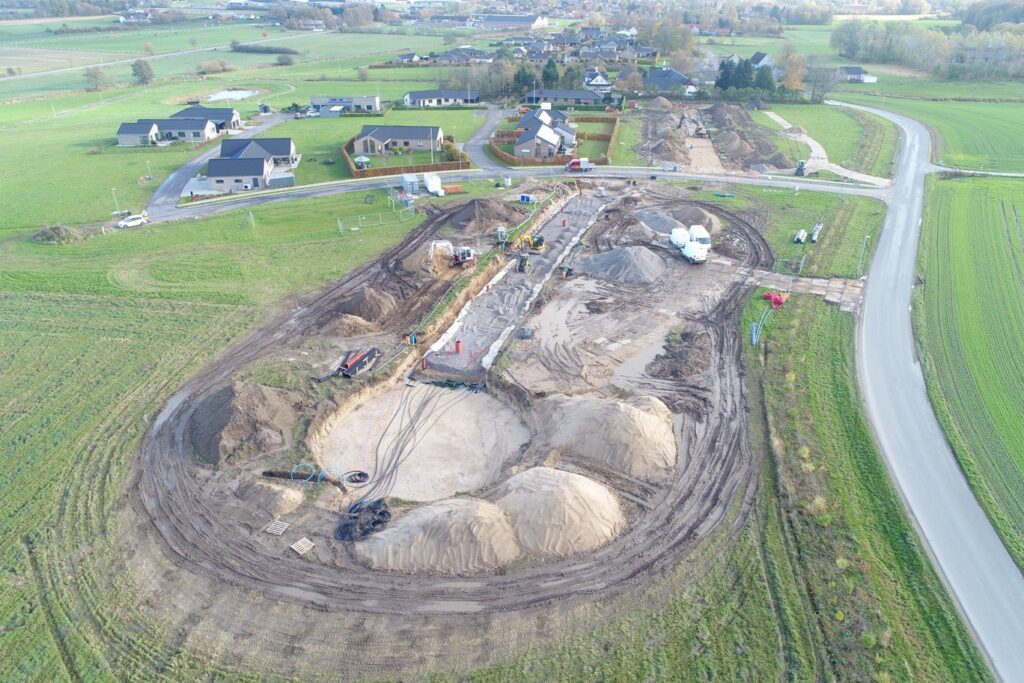
With heat exchangers installed in connection with rainwater collection, the wet weather can help supply energy for the heating. Such a system is installed in a pilot project in Denmark. It is called: The Thermoroad
On Vestergårdsmarken in Hornsyld, a new road for private houses has been born with a thermonet. The primary source of energy for heating the houses in winter comes from six horizontal heating probes that extract energy from the rainwater. The water from roofs and paving areas is led down under the asphalt and stored in a special sand layer, which makes it possible to store rainwater from a 100-year event without straining the sewer network. When there is capacity in the sewer network again, a water brake is opened and the rainwater is let out.
Utilization of rainwater as an energy source is an obvious consideration when new residential areas are established or when renewal of the sewage system is required for existing residential areas.
Energy piles
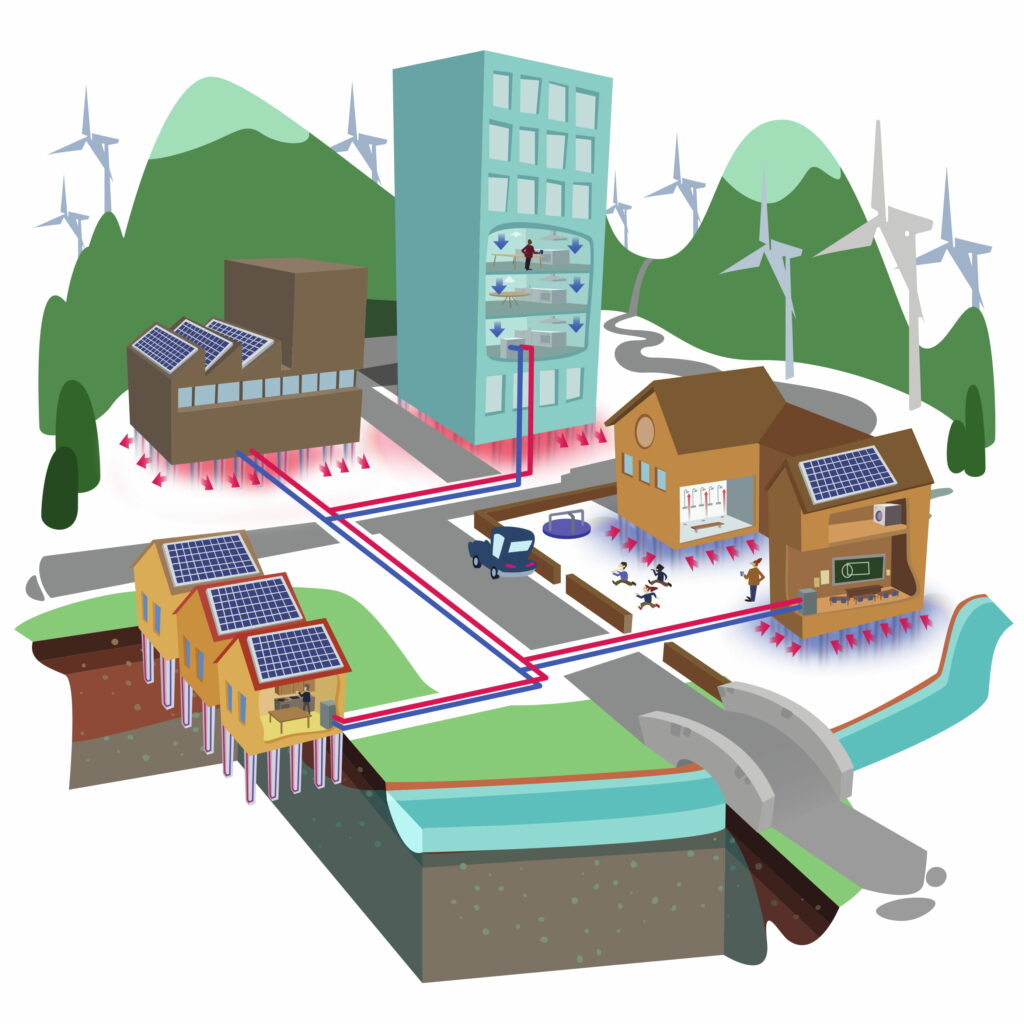
When prefabricated piles are used to support the foundation of a building, why not upgrade the piles to energy piles? Energy piles have been well documented in an industrial PhD project in collaboration between VIA University, Aalborg University and Centrum Pæle: https://vbn.aau.dk/en/publications/design-and-performance-of-energy-pile-foundations-precast-quadrat
Energy piles are among the cheapest energysources for a thermonet.
Energipæle hører til blandt de billigste energikilder til termonet. Especially because they are suitable for both heating and passive cooling. It should almost be a legal requirement that you have to buy energy piles when a building is to be founded on piles, unless you can prove that it doesn’t make sense. Everything else is a waste of good energy.
Air
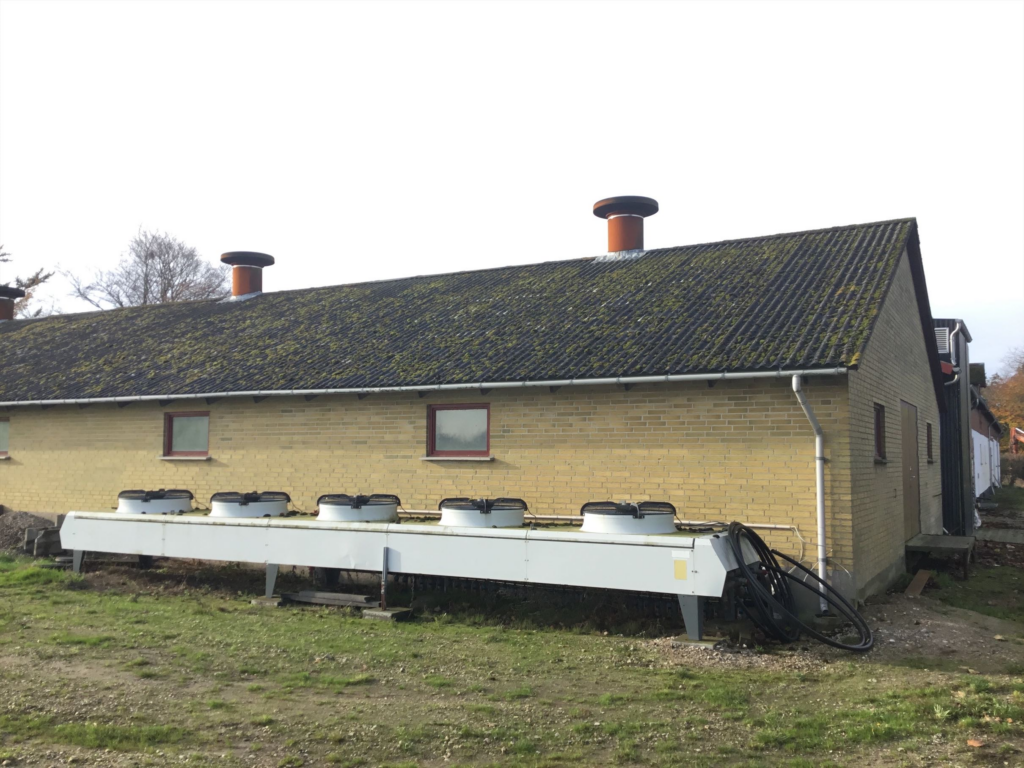
When the air temperature is warmer than the ground temperature, it is obvious to extract heat from the air and store it in the ground for later use. Føns Nærvarme has set up a dry cooler for that purpose.
Føns Nærvarme is one of Denmark’s smallest district heating companies, 53 households. The plant started out with a wood-burning stove. Later, it was expanded with two geothermal heat pumps, which, with the help of more than 10 kilometers of horizontal pipes, deliver the majority of the heat to the houses. With the help of the dry cooler shown, the outside air can be used to charge the ground and thereby achieve a better degree of efficiency on the heat pumps. Of course, the same trick can also be done on a thermonet.
The soil is particularly suitable as a thermal battery, which is why the harvested energy can be stored for longer periods. A solution that is not possible with individual air/water heat pumps, which are slaves to the temperature that is in the outside air.
Just as there are ground source heat pumps that can start by using the air as an energy source, and can later be easily connected to the thermal grid, one can also imagine that dry coolers like this can be used as a temporary energy source for a small group of houses during the expansion phase of a thermonet. It can ensure faster conversion projects.
The photo was taken by Martin Vesterbæk from EWII Energi.
Comfort cooling
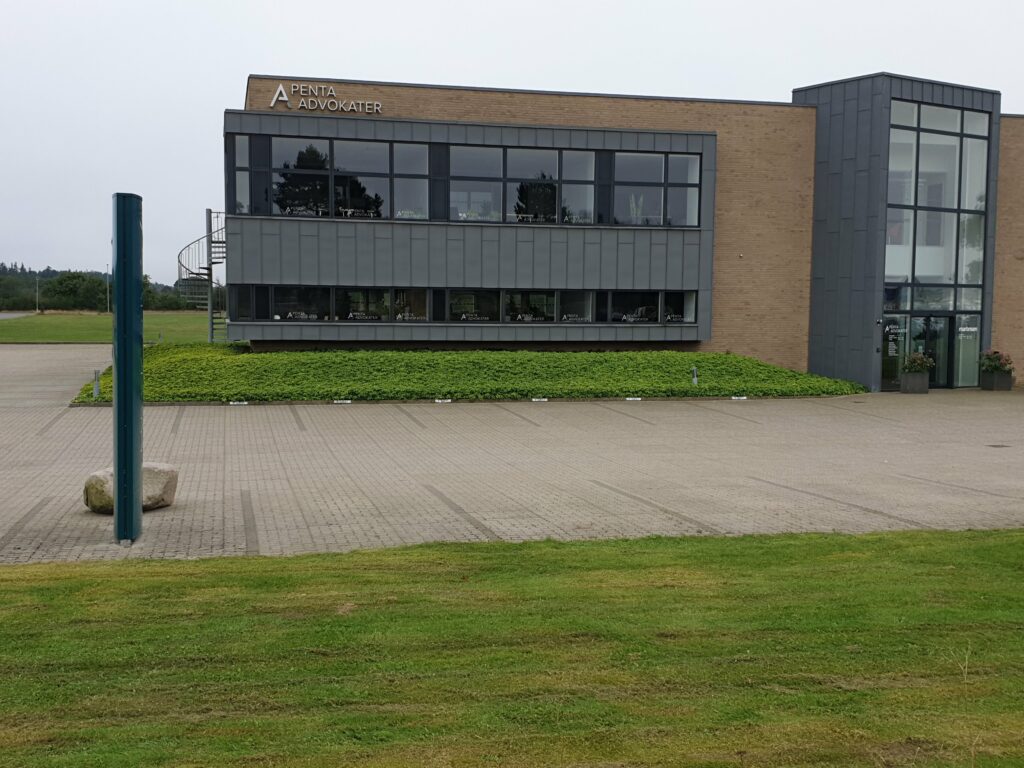
Cooling of office buildings does not need to be done with air conditioning systems that have high electricity consumption and heat loss. With passive cooling, the heat can be cooled off with high efficiency and stored for later.
Although there are not yet buildings connected to the thermonet that take advantage of the possibility of passive cooling, many members of Termonet Denmark have good experience from individual installations.
Penta Advokater struggled with a cooling system for their office in Grindsted that did not work properly. In 2017, Bravida, GeoDrilling and Klimadan provided a solution to the problem. Here, the conventional active cooling units on the roof were replaced with passive cooling from the ground. Two heat pumps replaced the gas boiler in the building, so that the heat could be retrieved from the ground in winter.
VIA University College demonstrated an average efficiency rating (EER) of 25 on passive cooling of Rosborg Gymnasium using energy poles from Centrum Pæle. Measurements were made in the hottest summer months in 2018. The highest temperature in the cooled teaching rooms was 23 degrees, while the reference rooms without cooling were at approx. 28 degrees, with peaks around 30 C. And the heat was seasonally stored in the ground instead of being thrown out into the hot summer air. (https://www.mdpi.com/1996-1073/12/14/2697)
A similar level of efficiency has been documented on a private detached house, where Vølund Varmeteknik has supplied a heat pump with built-in passive cooling. From October 2017 to October 2018, the heat was cooled off with an efficiency of 27.4, whereby the temperature could be kept down to a comfortable level.
Several other members of the association have experience from projects where the ground is used for passive comfort cooling of buildings. With this, an invitation to share further experiences and links to cases in the comment section.
Remediation wells
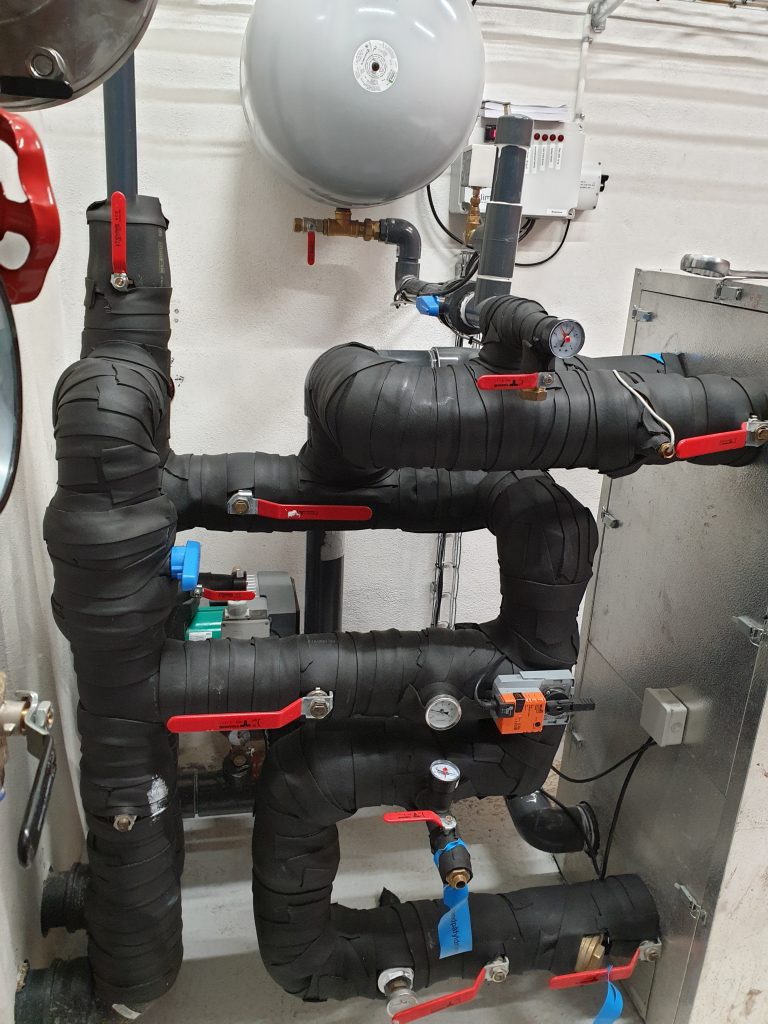
The residential community in Denmark called Mageløse has a thermonet that is connected to a remediation well. The well prevents pollution from spreading, but also supplies energy.
The project is a good example of resource utilization of heat that would otherwise have been wasted, and at the same time the residents save a lot of money on the heating bill. Normally, the water from such a remediation well is simply discharged after it has gone through a cleaning process.
If you look up the danish national drilling database and select boreholes with remedial purpose, the number is 534. These are boreholes from which water is pumped up, with the aim of avoiding the inappropriate spread of pollution, just as it happens at the remediation station at Mageløse.
A group of innovative-thinking new builders in the residential community investigated the possibility of utilizing the energy in the water. In collaboration with Klimadan, they established a heat exchanger at the remediation station and led a thermonet to their building sites. In every house there is a heat pump from Thermia, which is used to extract energy from the purified water from the remediation station before it is discharged.
35 m3 of water is pumped per hour at the remediation station, which is three times more than the homes need in a peak load situation. In principle, it is therefore possible to connect several more homes to the same thermonet without increasing the number of energy sources.
Electric heaters
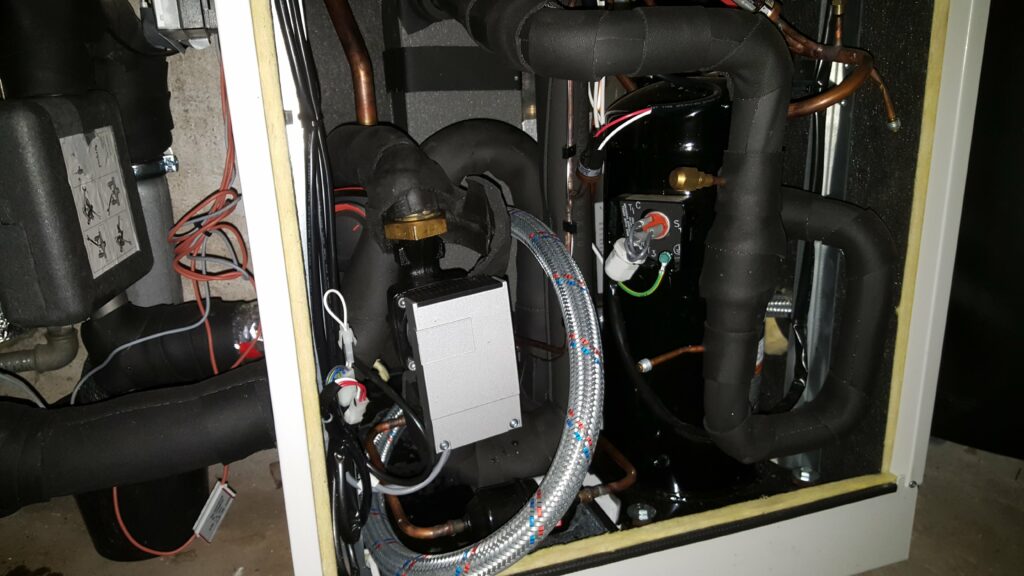
Most geothermal heat pumps have an auxiliary electric heater. It is used for legionella protection and as a backup if the heat pump does not work. It could also be used to heat the ground in the event of an excess of electricity in the grid.
Technically, it’s not that complicated. Ground source heat pumps, which are prepared to offer passive cooling, takes heat from the house, and puts it into the ground. If you then imagine that the electric heater in the heat pump switches on while that process is going on, it is no longer the house that is being cooled, but the heat that the electric heater emits.
It would naturally make sense to start by heating up the house and the domestic water tank as much as possible without compromising on comfort. Only then does it make sense to store the excess power as heat in the ground.
Ground source heat pumps already exist today, which organize their heat production according to the price on the spot market. But we are not familiar with solutions such as the one proposed here. On the other hand, one can imagine that it will become relevant in the future, when increasing shares of solar and wind in the electricity system increase the need for balancing capacity and have an impact on fluctuating energy prices.
The idea could also be used in combination with wind turbines or solar cells, which instead of being disconnected from the grid when there is overproduction, are set to supply energy to the ground.
PV-T panels
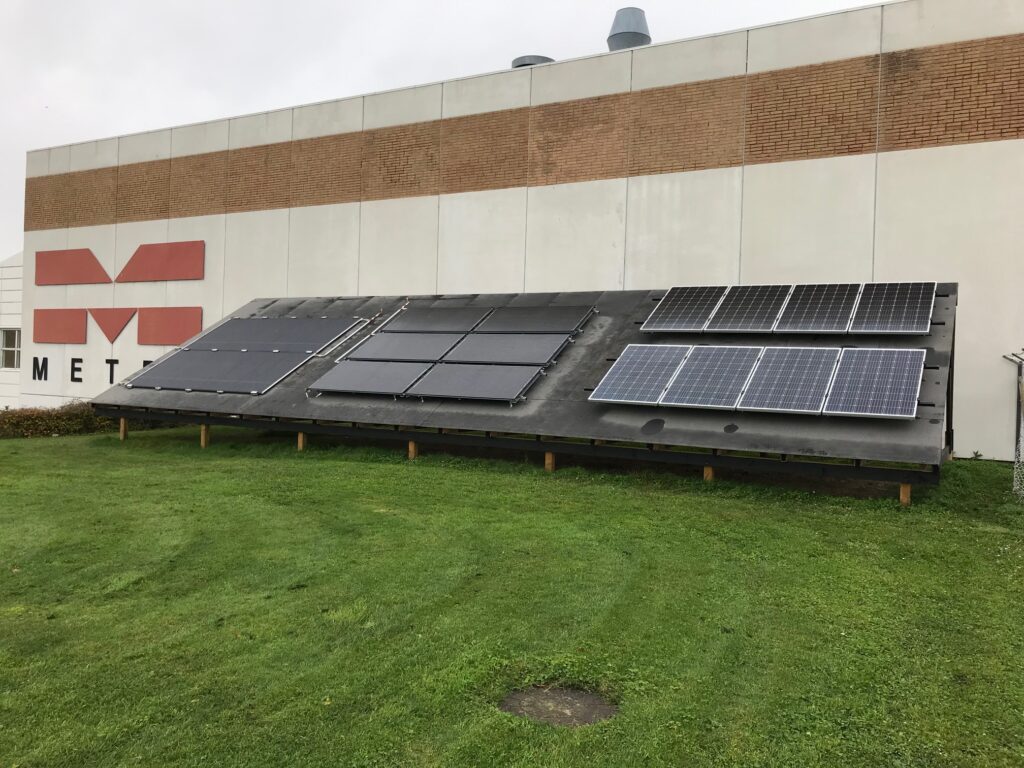
A PV-T panel has to functions. The front consists of solar cells (PV) that convert sunlight into electricity. The back side is a heat exchanger (T) that absorbs thermal energy.
The thermal energy comes both from the ambient temperature, from daylight and sunlight. The heat exchanger also helps to optimize the output from the solar cells, as they are cooled and thus deliver the optimal degree of efficiency for power production even on a hot summer day.
The brine from the panels is used as a heat source for e.g. a heat pump. Heating with modern PV-T panels is a sustainable and maintenance-free form of heating that can supply the associated heat pump installation with the necessary electricity supply and thus keep the installation energy neutral.
PV-T panels are an interesting energy source for a thermonet, because there can be interesting perspectives in establishing the PV-T panels in energy communities, which can ensure lower electricity prices for all consumers in the community. Furthermore, they can turn consumers on the thermonet into prosumers, who produce energy for storage in the grid when the temperature is higher than the ground temperature, as the panels will have an overproduction of heat in the summer. Finally, the temperature in the thermonet can help to cool the panels and achieve a more efficient power production.
METRO THERM has developed a small wall-hung brine-water heat pump, METRO Delta, which is ideally suited to the thermonet. The operating envelope and operating parameters for METRO Delta are further optimized so that it can be connected directly to PV-T panels. Here, it is important to be able to operate at very low temperatures, as well as ensure stable start-up of the heat pump, also against the panels stagnation temperature in summer.
METRO Delta was formally launched for PV-T operation in the Netherlands in autumn 2022 by the collaboration partner, Triple Solar. The first major project in the Netherlands has been in operation since February 2022 in Barendrecht near Rotterdam. Here, METRO Deltas supply heat, hot water and cooling in summer to 93 apartments via PVT panels on the roof.
Energy collectors
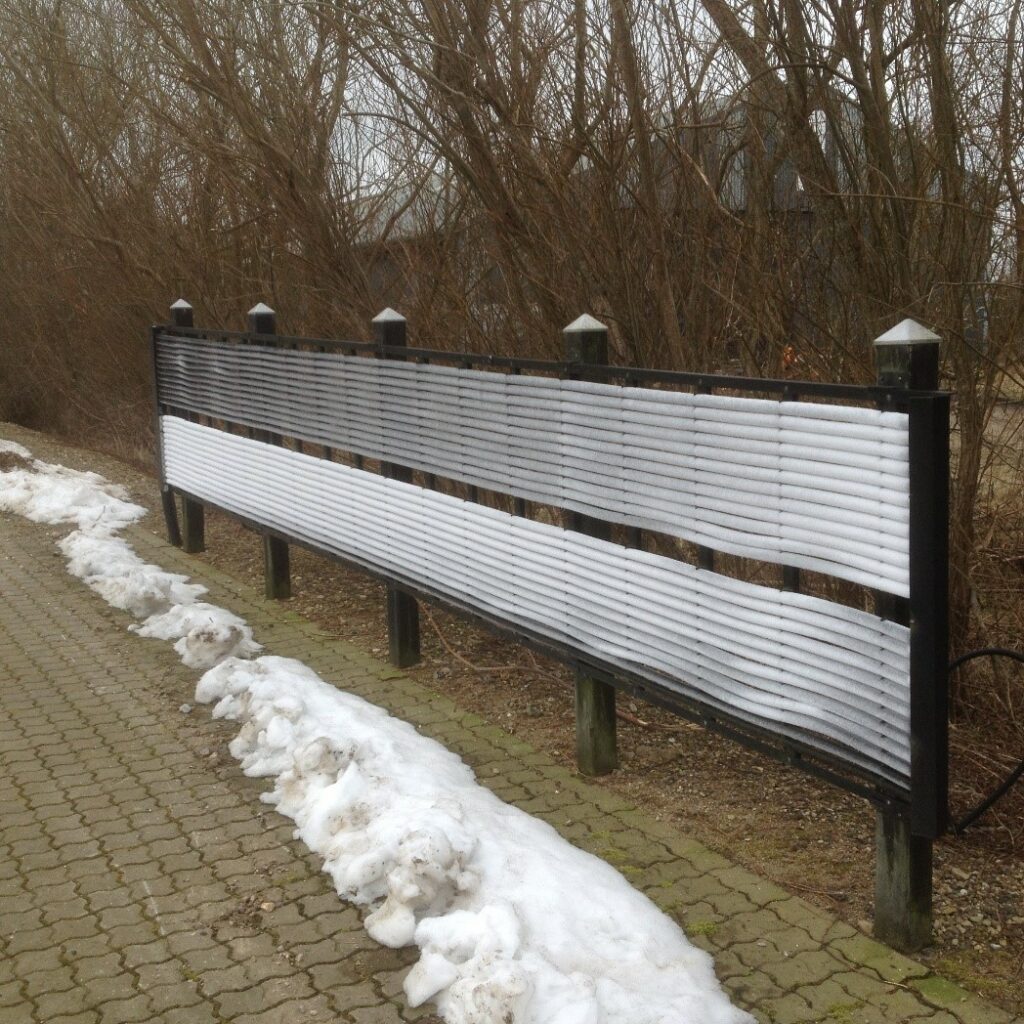
An energy collector is a broad term for a device that absorbs energy from both sun, wind and rain. In the picture, the energy collector is shown as a fence, but they are made in different designs.
Yesterday’s energy source in the calendar, PV-T panels, are a special kind of energy collector. Similar to these, there will be a large part of the year when energy collectors are warmer than the ground. On an individual plant, the energy collector can relieve the ground heating pipes during this period, just as energy can also be supplied to the ground.
When an energy collector is connected to a thermonet, the solution becomes even more profitable. This is because the temperature is so high in the summer months that the energy collector will undeniably lose some of the harvested energy because the temperature in the small individual plant becomes too hot. Also, energy collectors connected to the thermonet can be placed in places where it does not take up space on the individual home owner’s property.
PlanEnergi has been kind enough to provide the image in the post. The cold brine from the heat pump comes up in the energy collector in the lower left corner and turns at the right end. Along the way, you can see that it is heated by the air. An image that is also used in a report that PlanEnergi made for Gate 21 in the Interreg ØKS project FUTURE. Here, in a calculation, it was possible to show how small thermonets in clusters, which made use of ground heat and energy collectors, were cheaper than individual solutions.
Drinking water pipes
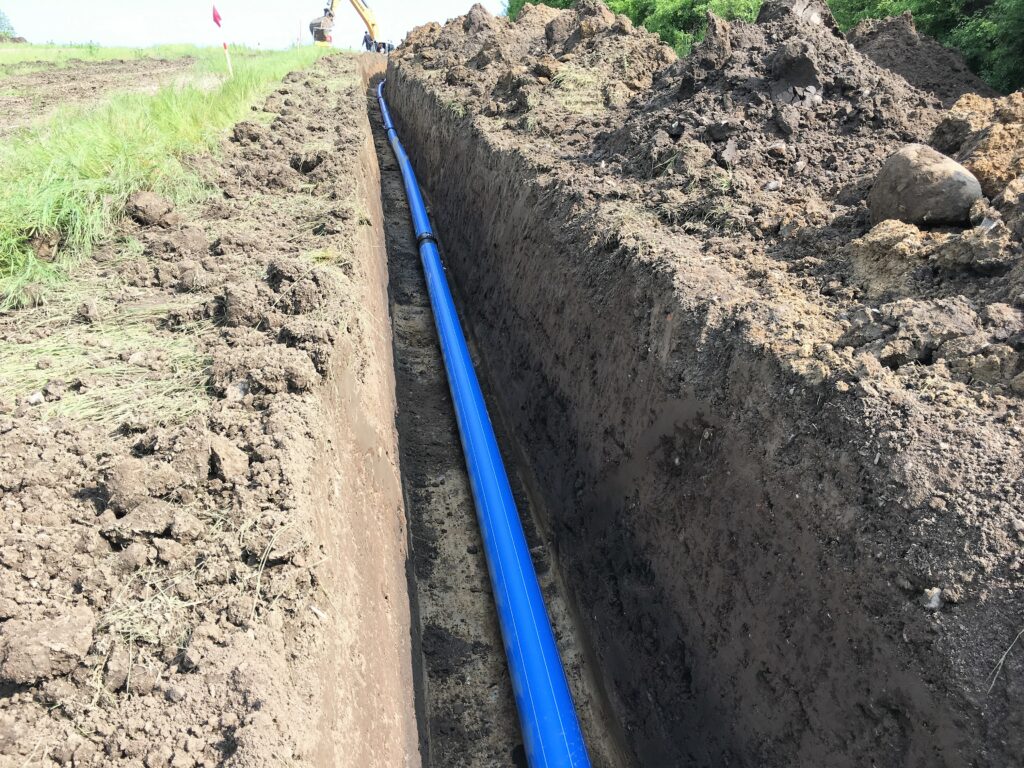
Drinking water pipes are uninsulated pipes that resemble the pipes in a thermonet. If the water in the pipes is colder than the ground, it will therefore absorb heat from the ground on its way to the tap.
Drinking water is approx. 8-9 degrees in Denmark when it comes up from the borehole at the utility company. During transport, the temperature of the water is affected by the surrounding soil. If the ground is warmer, the drinking water is heated. If the ground is colder, the drinking water cools down.
One can therefore advantageously extract heat from the water and cool it down to an artificially low level, with the purpose of using the thermal energy for heating. This is used in a holiday resort in Denmark where energy is extracted from a large drinking water line that runs right past the holiday resort.
It is important that the water has some transport time in the pipe after the heat has been extracted. If the water arrives at private households at a lower temperature, it will cost extra money on the electricity bill. Because then the stove, the coffee machine, the washing machine, the dishwasher and the hot water production have to compensate for the energy used. In many cases by using electrical heaters.
A study by HOFOR and DTU published in 2019 investigated the potential of making large groundwater heat pumps in Copenhagen (https://www.sciencedirect.com/science/article/abs/pii/S0360544219324685). The study showed that only 29% of the harvested energy had to be compensated at the consumers, and that was without including the heat absorbed from branch lines in the calculations. At the same time, the study also showed that by cooling the drinking water, in the month of August, you could comply with the recommendation of a maximum of 12 degrees hot drinking water 81% of the time, compared to 42% of the time when the water was not cooled by the heat pumps. Here, a health benefit was achieved.
Many of the villages in Denmark where a thermonet would be a relevant solution have consumer-owned water utility companies with board members from the local community. Here, one could consider letting the idea start, of establishing a local heating company, which establishes a thermonet with energy from the drinking water as the primary energy source.
Because the thermonet is typically built from pipes known from the drinking water industry, according to principles known from the district heating industry, multi-utility companies are also obvious actors to establish thermonets.
Cooling from grocery stores
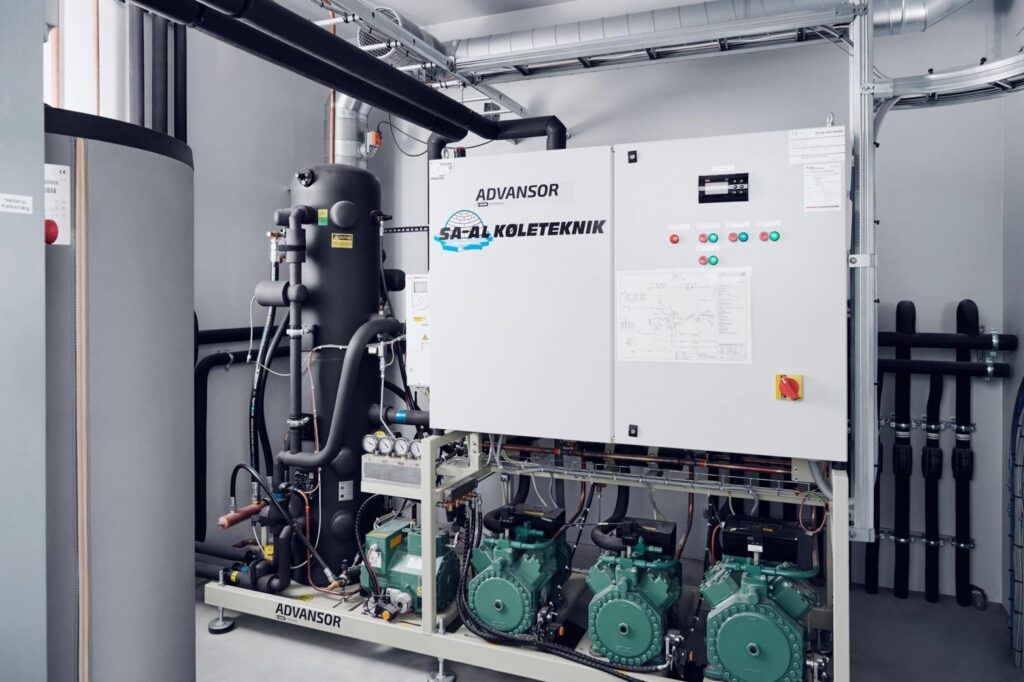
All grocery stores have a refrigeration system because they contain freezers that must keep the food fresh. The heat that is cooled off can be used to charge a thermonet.
Some grocery stores have both a heating system and a cooling system. The heating system warms up the store in the cold months so that customers do not freeze when shopping. The cooling system works constantly to keep the temperature in the freezers down so that the food does not go bad. In the most modern convenience stores, a device as shown in the picture is installed, which can reuse the heat from the cold room to heat the store. That is smart!
When the weather is warm, grocery stores have no need to heat up the store. Rather, they need to cool down the shop. Thereby, the cooling requirement becomes even greater. All the heat that is taken out of the freezers and the store is often led to the warm outside air and is therefore not used. In the convenience stores located in district heating areas, it may be possible to supply the heat that would otherwise be wasted to the district heating network. Danfoss has, for example, experiences with this method from a convenience store in Høruphav (https://www.youtube.com/watch?v=EBH7lWWjk8A).
But it can be even smarter with a thermonet. There are many grocery stores in villages where traditional district heating is not established. Here, the convenience store can advantageously be an energy source for a thermonet. We have had a chat with Rune Høyer from SA-AL Køleteknik, who made the system in the picture, and got him to make a loose calculation of how much heat a top-efficient convenience store in Denmark, which recycles all the heat it can, could deliver to a thermonet in the warm months.
Rune emphasizes that it depends on the size of the store, but a good bet for a smaller store would be that it needs to cool off 175 MWh over the course of a year. The majority must be cooled during the summer months. A standard house connected to a thermonet in Denmark will typically consume 12 MWh from the ground over the course of a year. This means that the grocery store can recharge the ground so that it can support the heating needs of almost 15 standard houses.
For the grocery store, the collaboration is a big win. The temperature in the ground is somewhat lower than the temperature in the air during the summer months. This means that the cooling system has a better degree of efficiency and thus a lower power consumption. In addition, the facility does not need to be as large when the ground temperature is the starting point for planning the facility.
Electrical substations
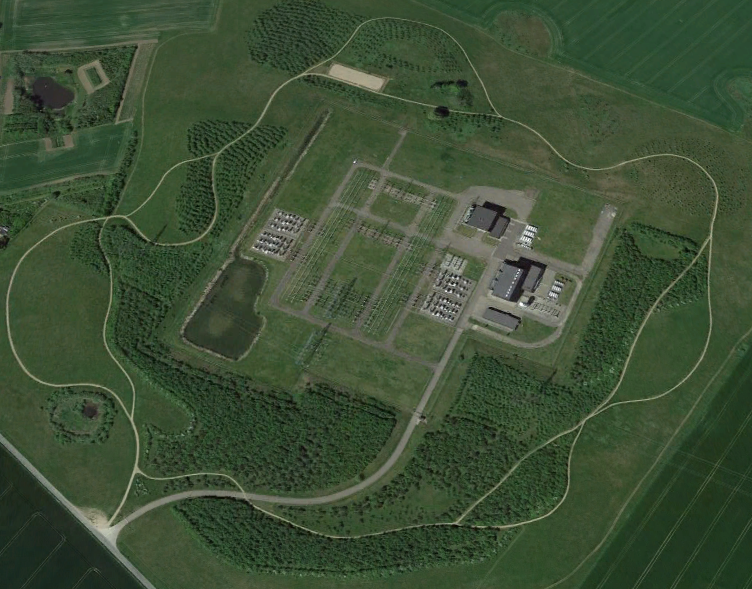
When electricity has to be transported over long distances, it takes place at a high voltage. When the voltage is transformed, heat is produced, and the equipment is cooled down. Heat from this cooling process can charge a thermonet.
The potential of utilizing waste heat from substations was investigated in the Interreg ØKS FUTURE project, which was led by Gate 21. In the project, PlanEnergi made an analysis where, together with Energinet, they looked at the waste heat potential of a concrete substation. The transformer station had enough waste heat to supply half of a city with approx. 3,000 inhabitants.
Part of what could make the thermonet particularly useful for absorbing energy from substations is due to operational fluctuations. In the analysis, there was three months of downtime during which there was no waste heat to be obtained from the substation. In such a situation, one can take advantage of the fact that the earth acts as a large geothermal battery. It will therefore take some time before the earth has run out of energy, even when nothing is supplied for a period. That a thermonet can be flexible in relation to the uptime of a waste heat source in this way is a big advantage.
Transformer stations of varying sizes are found all over Europe.
Horizontal ground heat exchangers
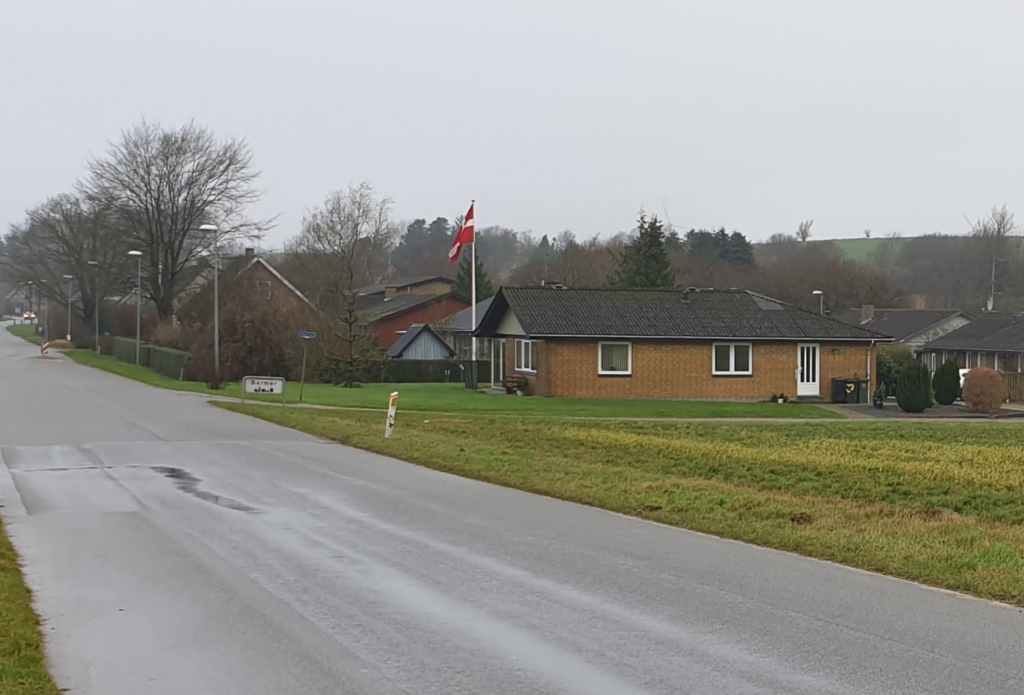
A well-known source of ground heating systems are the horizontal ground heat exchangers that are typically placed in the garden. For a thermonet, they can be established on surrounding fields.
When the pipes are established in a field, they can be laid at a depth where it is still possible to cultivate the field. The price of laying down several kilometers of pipes in a field is somewhat lower than the cost of having a few hundred meters laid in your garden. If it is possible to find a suitable location, the horizontal geothermal heating exchangers are among the cheapest geothermal heat sources for a thermonet.
The picture in the post is from Spættevej in the small village of Barmer, Denmark. On this road, since 2012, the houses have been heated with a thermonet. The heat comes primarily from horizontal ground heat exchangers that are placed in the adjacent field. The result was a well-functioning heating system that could be installed at a particularly advantageous price for the six homes on the road.
You can read more about the project here: https://gis.geothermal-dhc.eu/Case?id=7
Larger projects using horizontal ground heating pipes are on the drawing board in several villages in Denmark. In the town of Hjortsvang there are approx. 100 households and already after the first citizens’ meeting, there was interest from 45. A local utility company has been established and a project proposal has shown that constructing a thermonet and connecting geothermal heat pumps to a shared field of ground source heat exchangers is favorable economically to the alternatives.
It therefore pays to work together on the heat supply in the villages, rather than act separately.
Compressor stations
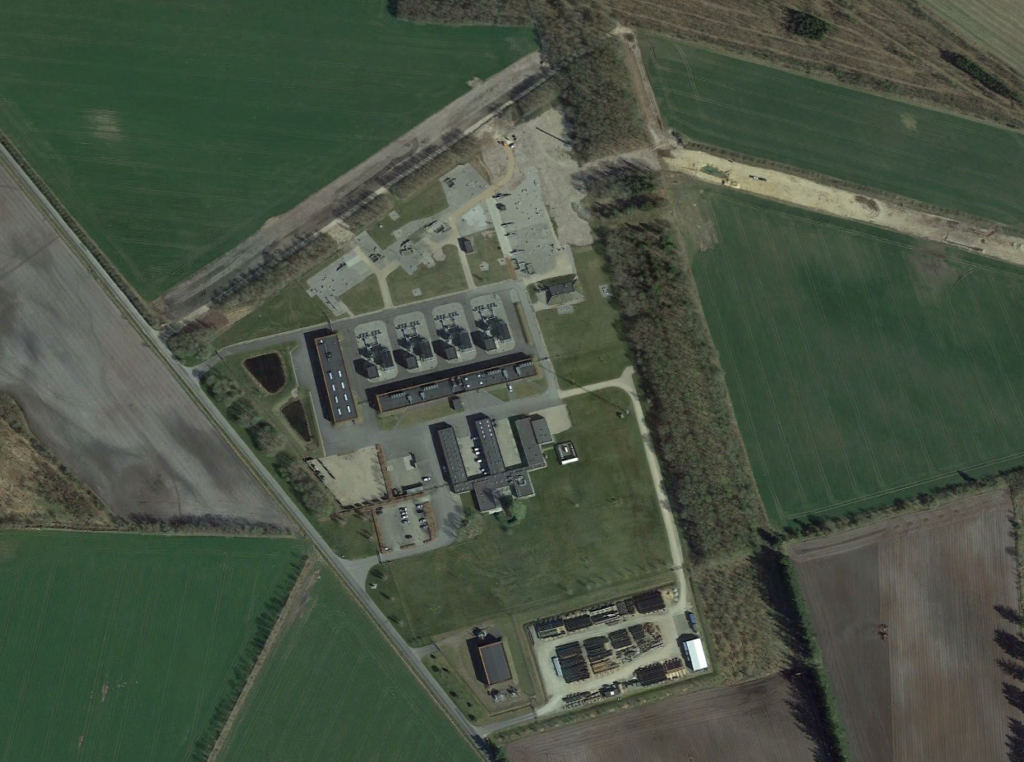
When gas has to be transported in large transmission lines, it takes place at a high operating pressure. It requires large compressors, which emit waste heat. Heat that can be used in a thermonet.
In connection with the construction of the Baltic Pipe, which has recently been put into operation, the Danish public enterprise Energinet built a compressor station in Everdrup, Denmark.
The heat that can be delivered from the compressor station in Everdrup fluctuates with the amount of gas that must be transported in the pipes. It is assumed to be 14 MW at 70% gas flow and up to almost 36 MW at 100% utilization. The compressor station is assessed in the report to be able to deliver 190,000 MWh over the course of a year. A standard house in Denmark connected to a thermonet can be expected to draw around 12 MWh from the ground. This would mean that a compressor station like Everdrup would be able to support the heating needs of almost 16,000 standard houses.
One could imagine that a possible heating center in Everdrup would make it possible to establish smaller, uninsulated transmission lines in the form of thermonets. These thermonets could reach small villages in the area, such as Everdrup, which today does not have access to district heating.
There are several compressor stations in Denmark, where the waste heat could be advantageously used for heating homes.
Wastewater treatment plants
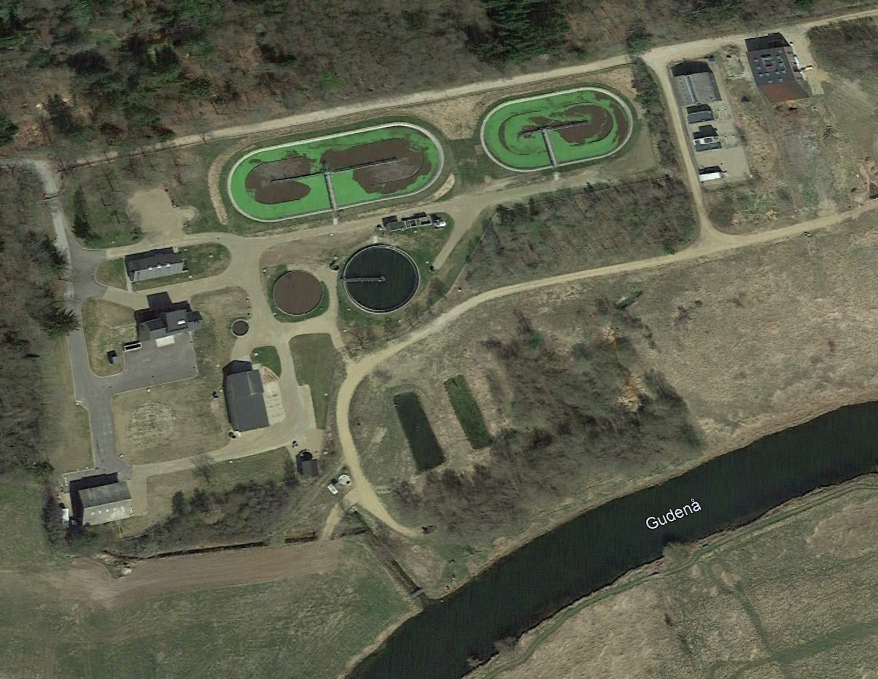
When the wastewater has gone through the treatment process at a wastewater treatment plant, the treated wastewater is lukewarm. It contains energy that could be used in a thermal network. It is estimated that lukewarm wastewater from Denmark’s 100 largest treatment plants has the potential to supply 250,000 households with heat.
One place where waste heat from a treatment plant is already being utilized is at Gudenådalens Energiselskab in Denmark. In the summer, when the heat demand is not so great, the heat from the lukewarm wastewater is stored underground. In winter, the lukewarm wastewater is used directly in a large heat pump, in combination with the heat stored in the underground in summer.
Using the subsoil as energy storage ensures that all the energy from the treated wastewater can be utilized. It is also smart because the amount of wastewater is not constant. The quantity is directly dependent on the diversion from the consumers and the amount of rainfall. By using the subsoil as a buffer, fluctuations can be smoothed out and heat production stabilized.
There are more than 600 wastewater treatment plants in Denmark. If you are to establish a thermonet, it is therefore good to be aware of whether there is access to store energy from treated wastewater.
ATES
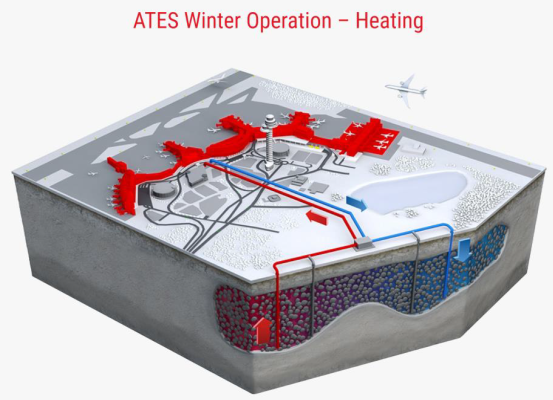
The abbreviation stands for Aquifer Thermal Energy Storage and covers open boreholes from which heat can be extracted and stored in groundwater reservoirs. This source is well suited for both heating and cooling.
In yesterday’s post, we talked about how Gudenådalen’s Energiselskab stores heat from treated waste water in the underground. This storage takes place precisely via ATES boreholes, which in the summer store the heat in an aquifer. In winter, the heated ground water can be collected and, together with the heat from the purified wastewater, ensure a high degree of efficiency for the heat pump.
ATES is also a technology used for heating and cooling individual buildings or industrial companies with a large heating and/or cooling demand. This applies, for example, to larger office buildings, hotels, airports, production companies, etc.
On the Danish market there are at least two companies who have a lot of knowledge of the establishment and operation of ATES facilities.
First, Hölscher Jensen, who has also been kind enough to supply the photo, has a sister company in Tjaden in the Netherlands. On the Dutch market, ATES drilling is a widespread and proven solution that has been used for the past 50 years. At Hölscher Jensen, they carry out ATES drilling themselves, just as they also offer to test, operate and maintain facilities for 5, 10 or 25 years.
Second, with the acquisition of Enopsol, Energy Machines has secured great knowledge and experience with ATES plants. Here they have secured almost 50 years of expertise from more than 30 installations. The company has, among other things, responsible for the establishment of Denmark’s largest ATES facility at Bispebjerg Hospital, where six pairs of boreholes cover 100% of the cooling needs in the summer and 50% of the heating needs in the winter.
Read more here: https://www.energymachines.com/cases/bispebjerg-hospital
Medium depth geothermal boreholes
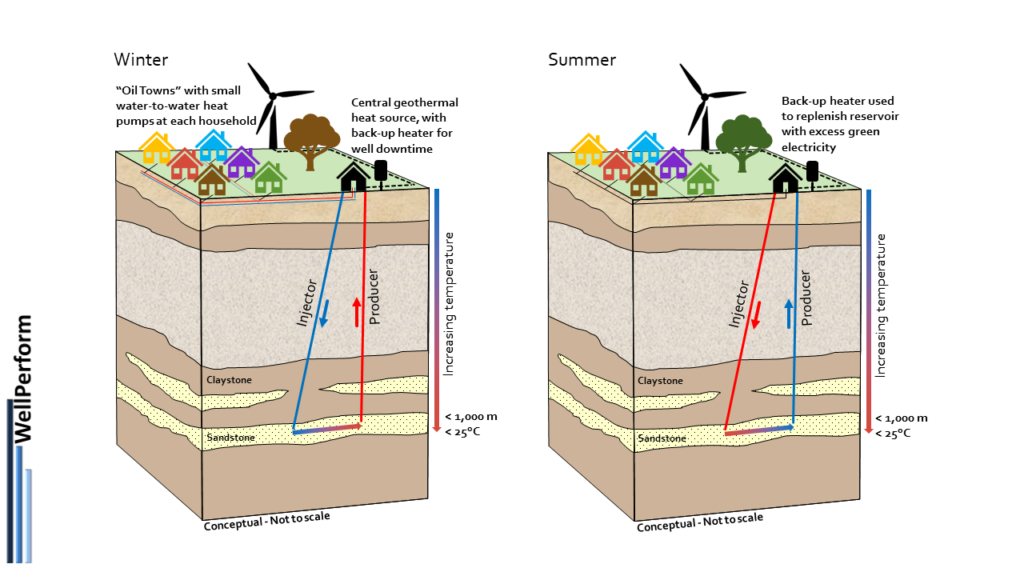
Geothermal energy is often perceived as deep boreholes where hot water can be brought up from underground. However, there are also energy-rich layers in the subsurface at other depths.
Where for instance Denmark has traditionally understood geothermal as boreholes that are typically deeper than one kilometers, the definition in the EU is differently broad. EU directive 2009/28/EC of 23 April 2009 on the promotion of the use of energy from renewable energy sources defines in Article 2, c) geothermal energy as: “energy that is stored in the form of heat under the solid surface of the earth”.
The European research network, COST Geothermal DHC thus distinguishes between three types of geothermal wells. Near-surface geothermal wells, medium-deep geothermal wells and deep geothermal wells. The medium-deep geothermal wells, which are today’s energy source in the calendar, are very similar to the deep geothermal wells we are used to hearing about in Denmark. There is, however, the difference that the temperature is not quite as high, and therefore one can imagine this type of drilling as an energy source for large thermonets.
The company WellPerform, has, among other things, investigated the potential for geothermal energy in various parts of Denmark. Here, areas have been found where boreholes with a capacity of up to 10 MW can be established with great certainty at a temperature of around 20 degrees. A temperature level where one could easily imagine that the transport took place in a large thermonet. A thermonet of this size could, for example, supply an industrial area with a large heat demand, e.g. horticulture. The network could also be used to connect several large heat pumps as a substitute for biomass-based heating at the district heating plants. Or as shown in the picture, where a larger village is thought to be supplied with heat from medium-deep geothermal boreholes.
The National Geological Surveys for Denmark and Greenland (GEUS) maintains an interactive map with the potential for medium-deep and deep geothermal drilling in Denmark: https://data.geus.dk/geoterm/
Sewer pipes
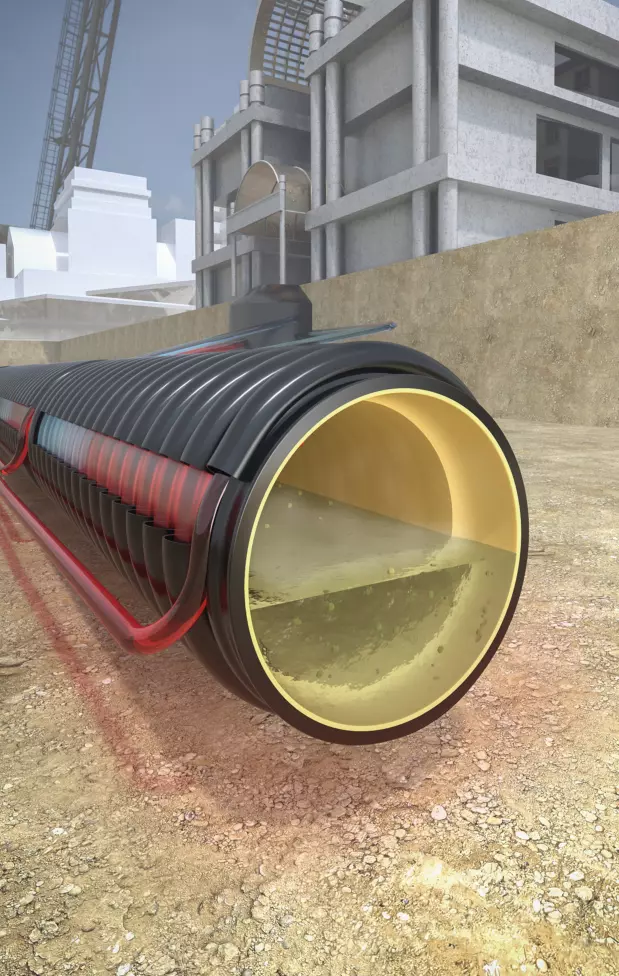
When sewer pipes are buried, it is obvious to harvest energy from the sewer pipes and the surrounding soil. The extra utilization gives greater value from the same excavation work.
The water we flush down the drain contains energy that can be used to advantage. When the wastewater in pipes is warmer than the ground, the heat is lost to the ground around the pipe. With the shown pipe PKS-Thermpipe from FRANK GmbH, it is possible to harvest the heat from wastewater pipes via the coiled hoses.
The amount of heat that can be collected in the wastewater line is not necessarily very large, however, as it depends on the fluctuating amounts of wastewater in the pipes. However, it does not matter much, because the pipes can also draw heat from the surrounding ground.
Read more about PKS-Thermpipe here: https://www.frank-gmbh.de/en/products/sewage-and-environment/pks_thermpipe.php
On the Thermoroad in Hornsyld, Denmark, which was mentioned in the calendar earlier, there have also been experiments with utilizing heat from the wastewater. No pipes are wound around the sewer pipes here. Instead, a probe is placed under the wastewater line that can absorb the heat from the ground around the pipe.
When you are in the process of digging and laying pipes for wastewater management anyway, it makes good sense to include heat supply in the project.
Lakes and rivers
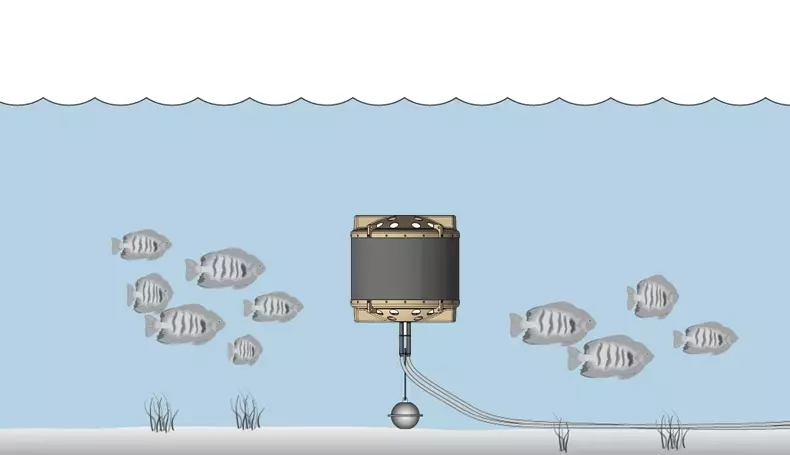
With a water heat exchanger such as FRANK WET, shown in the picture, you can take energy out of lakes, rivers and pools. It simply requires good anchoring of the water heat exchanger.
The picture shows how the water heat exchanger is anchored with a plumb line, but on FRANK GmbH’s website, you can also see how the exchanger can be mounted on a wooden structure. It could, for example, be under a jetty or similar: https://www.frank-gmbh.de/en/products/geothermal-energy/water-heat-Exchanger.php
The use of lake water as a heat source often requires a special permit, which must ensure that the animal life in the lake is not adversely affected by changed temperatures. The temperature in lakes in Denmark typically varies between 0 and 20 degrees throughout the year, but if there is a flow of groundwater, the temperature will be constant around 6 to 8 degrees.
Interreg ØKS supported the project FUTURE, which was completed in 2021, with Gate 21 as project manager. Under the auspices of this project, PlanEnergi made an analysis of a thermonet, where lake water was used as a heating source in a new built area for holiday homes. Here, the result was that ground source heat pumps, connected to a thermonet with energy from a lake, was the cheapest way to heat the houses, rather than establishing individual air/water heat pumps, as a reference.
Borehole heat exchangers
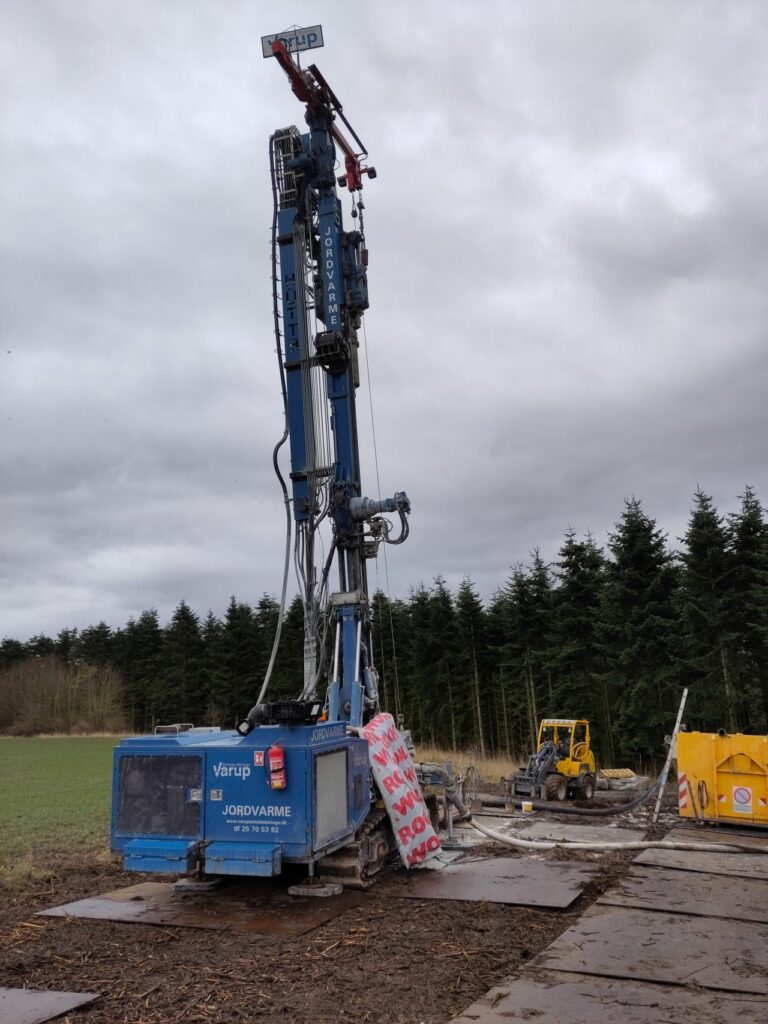
An energy source that very popular for existing thermonets in Europe. Borehole heat exchangers are used in nine out of the thirteen existing thermal grids in Denmark. This energy source requires a limited amount of space and is suitable for both heating and passive cooling.
In Denmark, closed loop borehole heat exchangers is still a nacent industry. GEUS and VIA University College has formed the intellectual basis through many research projects over more than 10 years. Simultaneously GeoDrilling, Varup Termiske Boringer and Weishaupt have all been responsible for the establishment of hundreds of boreholes in Denmark to supply buildings on individual plots with heating and/or cooling. Products from Dantonit are often used, which is the leading supplier of sealing material for geothermal boreholes in Denmark. A material that is both heat-conducting and sealing, so that the groundwater is protected.
In 2017, Silkeborg Forsyning made the first thermonet, where borehole heat exchangers were the source of energy. A preliminary project supported by Dansk Fjernvarme’s R&D account formed the background for the project, which obtained funding a program by Region Central Jutland. PlanEnergi was the project manager, while Klimadan, GeoDrilling and Varup Termiske Boringer were subcontractors.
Read more here: https://gis.geothermal-dhc.eu/Case?id=9
Damgaard Consulting Engineers was inspired by the project in Silkeborg, and has since been responsible for the establishment of three thermonets for new houses in collaboration with Lind & Risør. Read about them here:
https://gis.geothermal-dhc.eu/Case?id=14
https://gis.geothermal-dhc.eu/Case?id=6
https://gis.geothermal-dhc.eu/Case?id=13
In a recent project the utility company Høje Taastrup Fjernvarme rolled out district heating in a small village with the use of thermonet. Damgaard Rådgivende ingeniører did the planning, which allowed a lot of oil boilers to be replaced with heat pumps from Bosch. The energy source for this thermonet is also borehole heat exchangers that were constructed by Varup Termiske boringer in collaboration with GeoDrilling.
Borehole heat exchangers are one of the more expensive energy sources for thermonets in Denmark. The fact that it is still a popular energy source is because they can be established almost anywhere, take up a limited amount of space, and it has been shown that the thermonet with this energy source is still competitive compared to individual solutions.
Secondary aquifers
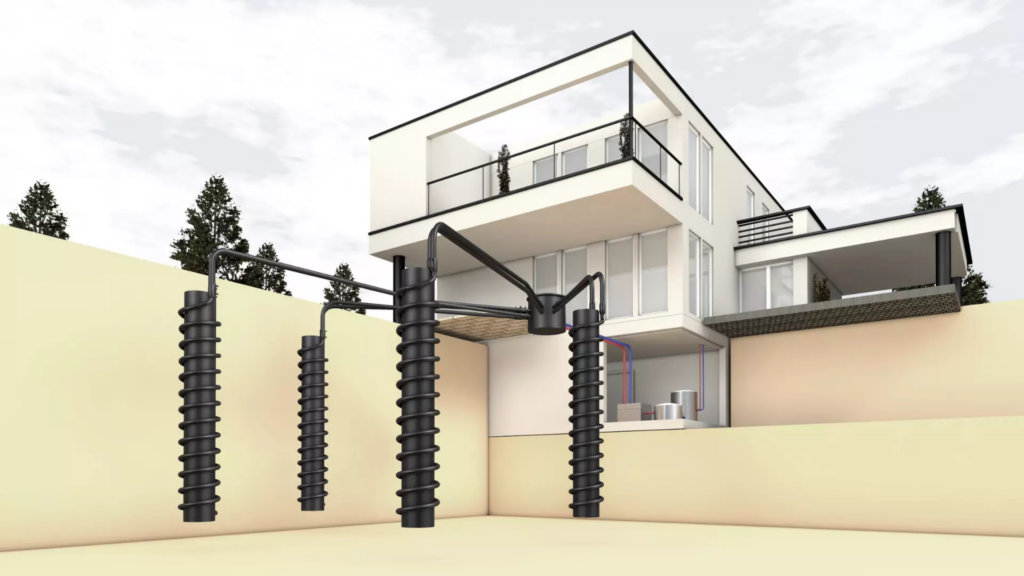
A secondary aquifer is often close to the surface. If there is flowing or stagnant groundwater close to the ground surface, it is obvious to consider it as an energy source.
In Denmark, there is a distinction between the primary aquifers, which are often deeper-lying reservoirs under a protective layer of clay, and the secondary aquifers, where drinking water interests are limited because they are close to the surface, where foreign substances have easy access.
Flowing groundwater is a good source of energy for both heating and cooling. In winter, the water adds new energy to the soil around the pipes. In summer, the water transports the heat away from the pipes. If there is stagnant water in the reservoir instead, it opens up the possibility of seasonal heat storage.
One way to access the secondary aquifer can be via the specially developed FRANK VTP® heat exchanger shown in the picture. The exchanger is the same type that was presented for waste water pipes earlier in the advent calendar. The vertical version is available in 6, 9 and 12 meter lengths. In addition to being used as a heat exchanger, the pipe in the middle can be used as a way to divert rainwater.
You can read more about FRANK VTP® here: https://www.frank-gmbh.de/en/products/geothermal-energy/vtp_vertical_thermpipe.php
One can also imagine that, with the help of near surface horizontal drilling, long stretches of ordinary PE pipes can be established, which are placed in the secondary aquifer. In the best cases, it will be possible to achieve a constant thermal conductivity of about five times higher than pipes that are not placed in ground water.
Sea water
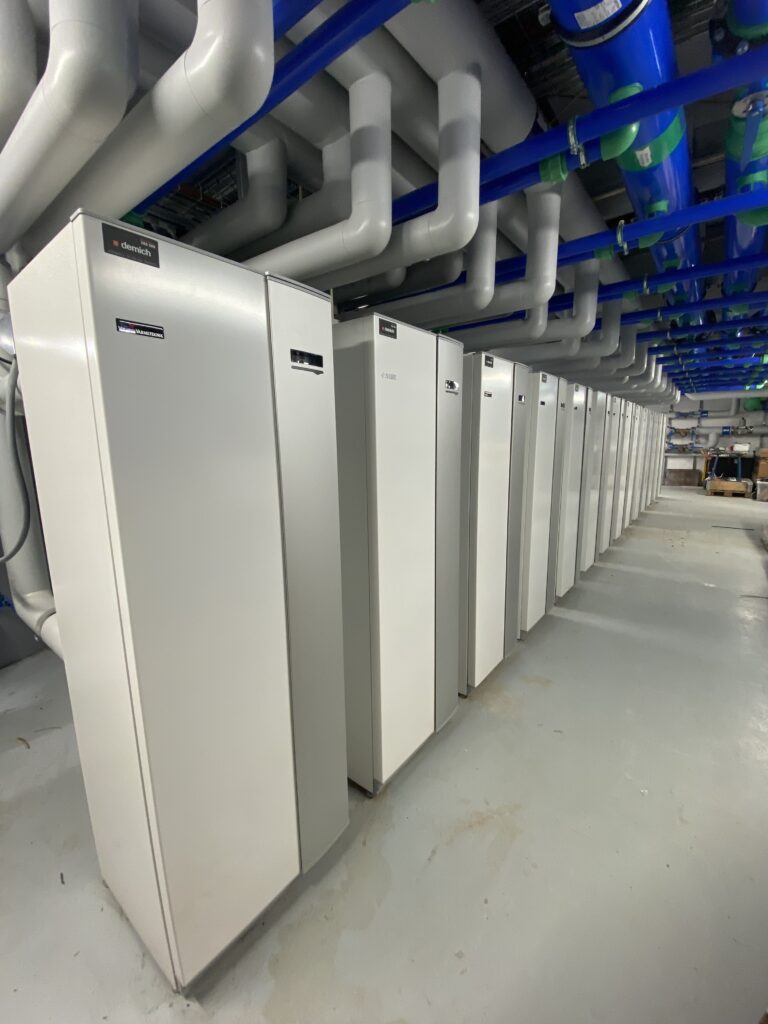
In countries with long stretches of coastline, it is obvious to use sea water as an energy source for a thermonet. Experience with the method is already known from several European countries.
In Esbjerg, Denmark, DIN Forsyning is building a large heating plant, for a traditional district heating system, with a 50 MW heat pump from MAN Energy Solution to be supplied with energy from the sea.
Vølund Varmeteknik, which has supplied today’s picture, has made a system on a smaller scale for a hospital in Torshavn on the Faroe Islands. The hospital in Torshavn is supplied with heat and domestic hot water from a cascade solution with 14 Vølund heat pumps with energy from seawater and excess heat. The solution was originally offered with a large heat pump, but through dialogue with the consultant and client, it was changed to a solution with several heat pumps in cascade due to the large power range, great operational reliability, as well as easy accessibility and low costs in connection with maintenance. The project was made together with Vølund Varmeteknik’s Faroese partner P/F Demich, who was involved both before, during and after the installation.
From the solution at the hospital in Torshavn, it is not difficult to imagine another solution where the heat pumps are not located in one heating central, but instead located on several different locations, connected by a thermonet. Buffa et al. (2019: https://www.researchgate.net/publication/331009863_5th_generation_district_heating_and_cooling_systems_A_review_of_existing_cases_in_Europe) identified five thermal grids that utilized seawater as an energy source. One in Norway, one in the Netherlands and three in Italy. The plants have a capacity of between 1 and 7.4 MW.
Asphalt
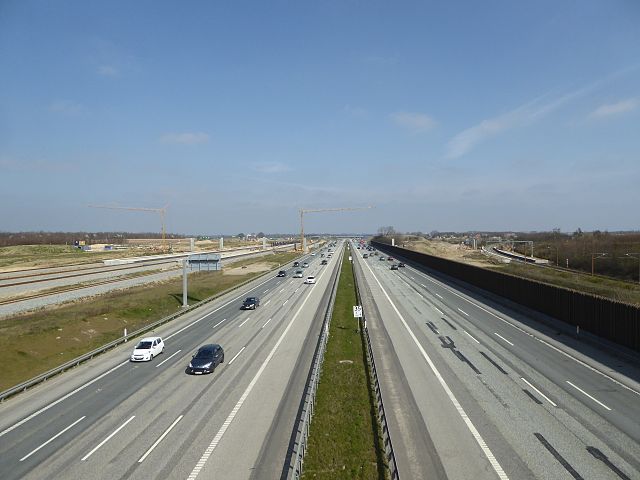
Where there is movement, there is heat. On a busy road there is a lot of both. Under the asphalt on a motorway, at a depth of one metre, it is easily more than 30 degrees in the summer.
Henrik Pennerup (WSP Denmark) has offered knowledge for today’s post. The information about the 30 degrees at a depth of one meter comes from a report published by Danish authorities. The report also states that the asphalt can reach a temperature of as much as 70 degrees when the sun is shining in the summer. The high temperatures are a challenge for durability, which is why large amounts of polymers are added to prevent the roads from becoming rutted. If the temperature could be kept down in the summer, it would be possible to use cheaper and more durable materials, and thus lower the costs of establishing and maintaining the roads.
This is where a thermonet could come into play. By establishing pipes under the asphalt, as well as in noise embankments and/or boreholes, the material below the asphalt can be cooled and the heat stored. The road will thus act as a large solar collector that stores heat which can be distributed to large or small geothermal heat pumps near the road.
If there are no buildings with a need for heat nearby, the heat need not be lost. It could be advantageously used to keep bridge and ramp installations frost-free in winter. Salting bridges in particular can be a costly affair, as they have no natural access to heat from the underground. Being able to reduce the need for salting also helps lower maintenance costs.
The idea illustrates that it is also possible to imagine a thermonet being established, where no geothermal heat pumps are connected to the network at all. Thus, the idea is a good example of the creative thoughts that can arise when you start thinking of the earth as a thermal battery, and the thermonet as a way to promote sector coupling by transporting thermal energy at low temperatures.
Biomass
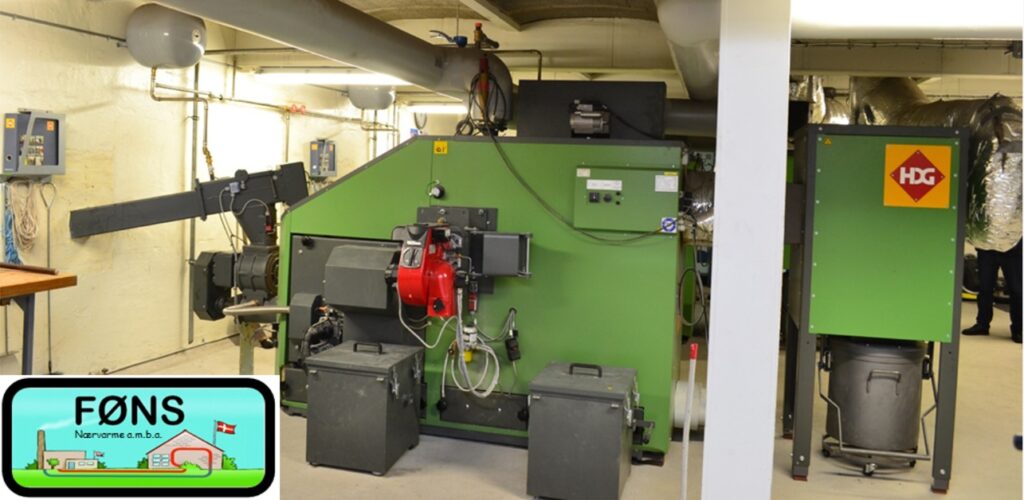
A thermonet with biomass as the primary energy source would not make much sense. As a temporary solution or backup, that’s a different story. Eg. as a way to boost efficiency.
On the 24th of December 2021 at 17.00 the power went in more than 300 houses in the Danish city Fredericia, and it didn’t return for more than three hours. The reason was an unfortunate combination of a cold Christmas Eve, high electricity consumption in households and 32 air/water heat pumps that were installed on the same phase. The air/water heat pump’s performance and efficiency decrease with the outside temperature, while the houses’ heat demand increases at the same time. It cost the Christmas dinner for a number of families in Fredericia, and illustrates a risk of extraordinary peak loads on the electricity grid on extremely cold days if the heat pumps depend on the outside temperature.
The picture in the post is from the heating central at Føns Nærvarme, which also contributed to the Christmas calendar earlier. Even if the good people from Føns have not established a thermonet, there is much you can learn from them if you are interested in converting oil and gas boilers. Their plans to improve the efficiency of their heat pumps, by heating the ground heating pipes with a dry cooler, can be mimicked with biomass, in a way that does not depend on the weather. Today’s post is about how a scenario like in Fredericia could be prevented with the help of a thermonet.
With a biomass boiler connected to a thermal grid, you could raise the temperature during a peak load in the electricity grid, increase the performance and efficiency of the heat pumps, and thereby lower their power consumption. According to Carbon Neutral Energy, the COP of a ground source heat pump on an underfloor heating system can be raised by almost 100% by increasing the temperature in the network by 20 degrees. In this way, the heat pumps in Fredericia could have used one seventh of the electricity they did on Christmas Eve last year.
The idea of connecting a biomass boiler to a thermonet is not just hypothetical. According to Buffa et al. (2019), there is a thermonet in Switzerland where the real heat consumption turned out to be 2.5 times higher than expected during design. As a result, the two boreholes showed signs of too rapid cooling. This was counteracted by connecting a pellet stove as a temporary solution. The pellet burner could then be disconnected when a permanent solution with PVT panels that recharged the boreholes was commissioned the following year.
A thermal grid therefore makes it possible for the district heating companies to work with different energy mixes and sector coupling, when they convert the heat production to heat pumps, large or small.
District heating return pipes
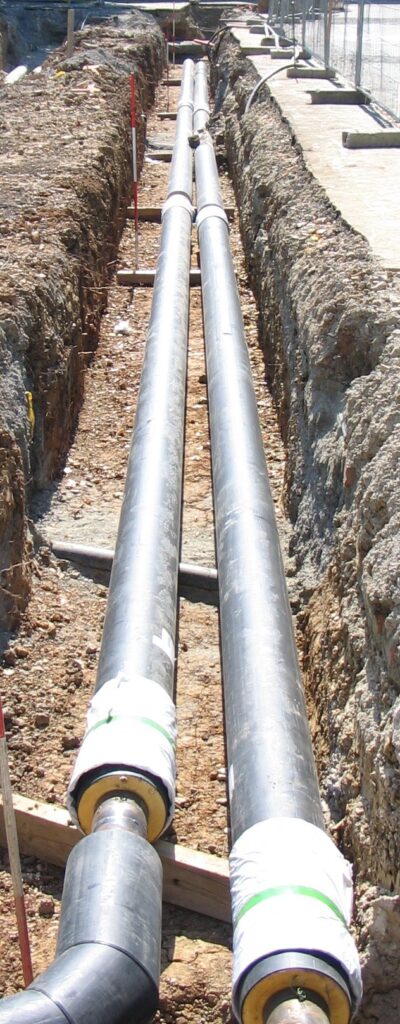
When the hot water in a traditional district heating network must be returned to the plant, it is an advantage that as much energy as possible is used for consumption. A thermonet can be an obvious customer.
Because the ground can act as a thermal battery, it is possible for the district heating plant to allocate energy to the thermonet in periods when it is otherwise difficult to get good cooling. In summer, heat consumption is limited, especially in newer houses. Here, domestic water heating is the primary need, and therefore much of the hot water will return to the plant with an increased line loss as a result.
One can therefore imagine that the return line is used to recharge a thermonet when it is about to run out of energy. In particular, a thermonet, which also uses closed loop borehole heat exchangers, can be established with far fewer geothermal boreholes if they can be recharged once a year.
It is wrong to think that energy from a return line is free. It still has to be produced at the plant. However, some forms of production particularly benefit from a reduced return temperature, e.g. if the plant has flue gas condensation or a large solar heating system. Here, the production price of the supplied energy is only a fraction of the normal production price.
For newbuilt areas, one can imagine a solution where, instead of establishing traditional district heating pipes, a thermonet is established that is connected to the return line. Consumers can use the thermonet for cooling in the summer and thereby be self-sufficient in energy for domestic hot water. In winter, the return line helps cover the heating demand.
As in yesterday’s post, the return line can also be used to increase the efficiency of the heat pumps when there is a need to reduce their power consumption.
The thermonet itself
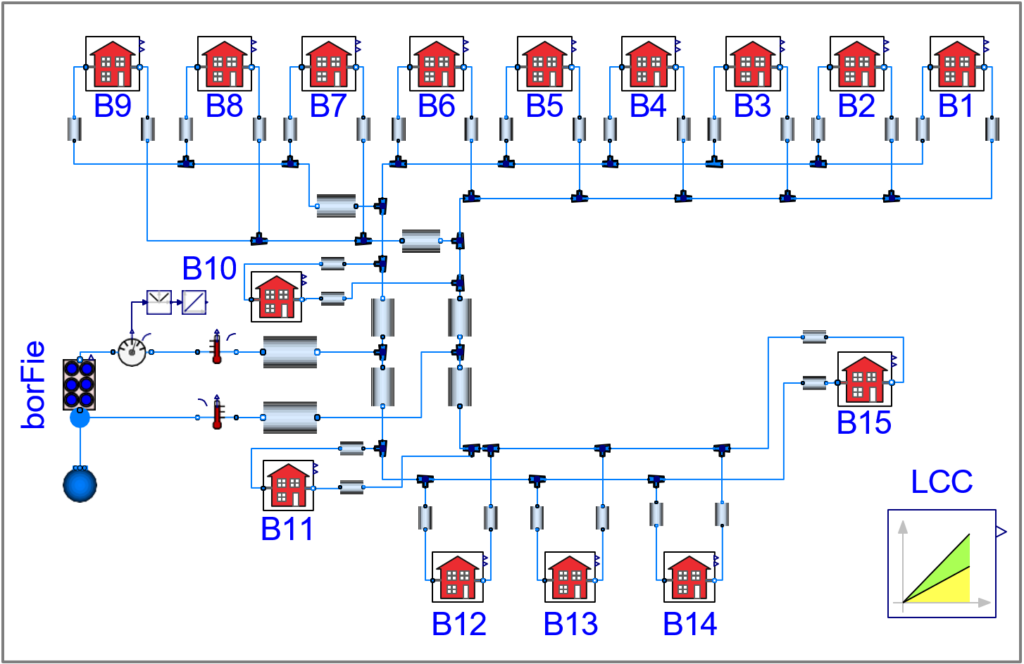
A thermal network is not just a distribution network that can connect geothermal heat pumps to a multitude of different energy sources. A thermonet absorbs heat from the ground, which contributes to production.
The uninsulated distribution lines in a thermonet are what make collective heat supply possible everywhere. Here, heat is not lost if there is a little more distance between the houses or if the connection percentage is low. No, instead of causing a line loss, it slightly lowers the need to establish additional energy sources.
In the Interreg ØKS-supported project COOLGEOHEAT, VIA University College and Lund University, in collaboration with the project’s other partners, have built a digital twin of the thermonet that Silkeborg Forsyning established in 2017. Based on extensive data from Kamstrup meters and the Thermia heat pumps’ online modules, a model of the entire system has been set up in Modelica. Read more about the model in Marwan Abugabbara’s dissertation: https://portal.research.lu.se/en/publications/district-heating-and-cooling-systems-transition-evaluation-of-cur
VIA University College has gone further and is developing a tool that can quickly dimension a thermonet with associated closed loop geothermal boreholes or horizontal pipes. The tool is called “pythermonet” an you can get an introduction from this freely available video: https://www.youtube.com/watch?v=_oFGTv2kj18
The work has shown that the thermonet itself in the project in Silkeborg supplies a fair share of the energy. It is this property of the thermonet that makes it possible to start with a few connections when setting up, and later build on more. When just the distribution lines are large enough from the start, you can later expand the energy sources as more consumers connect.
With this announcement, we round off this thermonet advendt calendar for 2023.
We would like to wish everyone a Merry Christmas and a prosperous New Year.
We hope that 2024 will be the year where Thermonet Europe will be founded as a non-profit association for the spread and development of thermonet in Europe. Please send an email to contact@thermonet.eu if you organization is interested in becoming a co-founder of this initiative.

Leave a Reply